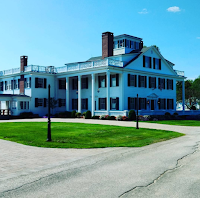Settlement will wipe $6 billion in student loan debt — but not for these borrowers
Last month, when more than 200,000 students who had been victims of misconduct by their colleges began getting the news that their federal student loans were cancelled, Amanda Luciano felt a sense of satisfaction — and a pang of despair.
The students getting the good news had been just like her — struggling with student debt because a for-profit college had defrauded them — with one difference, a difference that hadn’t seemed important until recently. When she needed money to start college, she was advised to borrow from a private lender instead of the federal government and, because of that, she’s stuck with $81,000 debt.
“I’m frustrated, because, what can I do? I’d be in the same position as these other people had my loans been federal, period,” said Luciano, who is now 37. “Of course, I’m so happy for these people, but it’s just crazy that no one’s being held accountable for us private [loan] people.”
A federal judge ruled last fall, in Sweet v. Cardona, that former students from more than 150 colleges (most of them for-profit institutions) who had filed what’s known as a borrower defense to repayment claim were entitled to automatic loan cancellation, such was the magnitude of those colleges’ misconduct. But when the final legal hurdle was cleared in February, erasing their debt, Luciano — and tens of thousands of private-loan borrowers like her — was left out.
The settlement came after a class-action lawsuit filed in 2018 that alleged the government had unfairly delayed granting relief to students who had been defrauded by their colleges. Although consumer protections apply to private lenders as well as the government, the legal mechanism that could trigger relief for private education-loan borrowers is different from the one used in the Sweet case, which sought relief only for students who had government loans.

Back in 2006, when Luciano was researching degrees that would lead to a good job in the fashion industry, she came across the website of the now-shuttered International Academy of Design and Technology, or IADT. The college promoted its national accreditation and promised a pathway to a lucrative career in design and merchandising, she said. Visiting the Chicago campus, Luciano met with a financial aid counselor to help her figure out how to pay for college. The counselor even got a representative from the private lender Sallie Mae on speakerphone to explain how easy it would be to pay off her loans after she graduated.
Nineteen years old and the first in her family to go to college, Luciano asked her grandfather to co-sign the loan and took the plunge. The degree proved worthless.
She borrowed $51,000; over the last 15 years she says she has paid back a total of $41,000. But because of the interest, her balance today stands at $81,000. Her current monthly payments of $500 only cover the interest, she says.
“These private loan borrowers are coming out of the exact same circumstances and the exact same context,” said Eileen Connor, director of the Project on Predatory Student Lending who represented the former students who started getting relief last month. “They have similar rights to cancellation. There’s no rationale to explain why one loan would be enforceable and another is not.”
Even though the private student loan market is much smaller than the federal one, it’s still very large — more than $127 billion is owed by private student loan borrowers, and delinquencies have been rising over the past two years.
Do you have a private student loan?
After Luciano graduated from high school, she initially enrolled at nearby Joliet Junior College, unsure exactly what she wanted to do but interested in teaching. She kept her job at her local Big Lots, where she had worked during high school. Living at home, she scheduled her classes for the morning and often worked a 1-9 p.m. shift. She was able to earn enough to pay the Joliet tuition out of pocket.
During her third semester, she took a class on fashion merchandising and fell in love with it. She felt like she had found her calling, she said, but there weren’t many classes in fashion at Joliet. That’s when she went online to see whether it was possible to get a degree in fashion and found IADT promising exactly that — just a train ride away.
She visited the school and an admissions representative repeated what the website had promised: Getting a degree from IADT would lead to a career as a buyer, a fashion designer or a virtual merchandizer, depending on which track she chose.
“They literally listed what would be available to us. They made it seem like, get this degree and here are the jobs you can have,” Luciano said. “So of course, I was like, this sounds perfect.”
Luciano says the financial aid officer at IADT never mentioned the option of federal loans and told her that a private loan was her best option since it would also give her money for living expenses.
“My thinking was, this is kind of what you needed to do — get a college degree to get a well-paying job,” she said.
Luciano’s interest rate is now over 9 percent and is not fixed, so it has risen and fallen over the years. The current interest rate on federal student loans is 5 percent, and once a student borrows, it doesn’t change over time.
After Luciano graduated from IADT in 2008, she searched for jobs in the fashion industry for several years.
IADT “promised networking opportunities, high paying jobs within our industry, even internship opportunities that lead to positions within the industry,” she recalled.
She contacted the school’s career services office at least once a week, she said, but they only sent her job listings easily found on any job website.

“I never thought to question the school in why this was all happening,” she said. “I just thought I needed to try harder, keep searching.”
She looked for jobs at stores with nearby corporate headquarters, constantly checking their websites to see if they were hiring, but positions were few and far between. She had one interview at the retail giant Claire’s for a buying position, but they were looking for someone with more experience.
In three years of searching, she never landed anything more than a $13-an-hour job at the retail store Kohl’s as an apparel supervisor, which did not require a degree.
“That was all I could find on the job boards,” she said. “I kept reaching back out to the school, but there was nothing. I finally realized this degree was worth absolutely nothing.”
Related: The unasked question about the student loan bailout: What’s colleges’ responsibility?
She moved back home with her mom and eventually decided to cut her losses. In 2011, she enrolled at the College of DuPage — a nearby community college — and became certified to teach preschool. She took out federal student loans to pay for the program.
“It was just so demoralizing,” she said. “And then to find out that this school — my school — was part of this predatory scam. After hearing that, I just can’t believe I’m still paying for it.”
In 2012, when Luciano started teaching preschool, the median annual salary for IADT graduates in Chicago was just $25,000 ten years after graduating, and more than half of students with federal loans were either delinquent or in default five years after starting repayment. In 2015, eight out of ten of the college’s bachelor’s degree programs failed the government’s “gainful employment” test — a measurement that looks at whether students, on average, are earning enough to repay their loans. In 2017, the year the college closed, 75 percent of its students with federal loans were delinquent or in default.
Those borrowers — the ones with federal loans — are getting relief from the Sweet settlement, and while the wait has been long, they got a break during the pandemic. They haven’t had to make payments since March 2020, and no interest has been added since then. Luciano, whose private loans are held by Navient, was allowed an 18-month pause, but her interest kept building up during that time. The company offers forbearances for economic hardships, but Luciano used up what was available when her son, now 6 years old, was born prematurely and she couldn’t work full-time.
A Navient representative declined to comment on Luciano’s situation, citing privacy concerns, and said that individuals with private loans who are facing repayment challenges should contact their servicers to inquire about available options.
Connor, of the Project on Predatory Student Lending, says she is looking into ways to help students like Luciano.
Meanwhile, Luciano, now a mom of two, has watched her fellow students from IATD posting images on Facebook of the emails they received alerting them to full loan cancellation.
“I’m so regretful, every day,” she said. “I just keep paying, but I’ll never be rid of it.”
This story about private loan forgiveness was produced by The Hechinger Report, a nonprofit, independent news organization focused on inequality and innovation in education. Sign up for our higher education newsletter.



